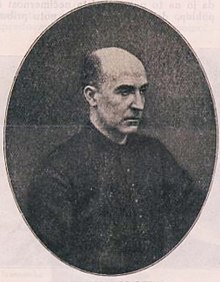Luis Coloma
Luis Coloma | |
|---|---|
 | |
| Born | Luis Coloma Roldán 9 January 1851 Jerez de la Frontera(Cádiz), Spain |
| Died | 10 June 1915(aged 64) Madrid,Spain |
| Other names | Padre Coloma |
| Seatfof theReal Academia Española | |
| In office 6 December 1908 – 10 June 1915 | |
| Preceded by | Valentín Gómez Gómez |
| Succeeded by | Wenceslao Ramírez de Villa-Urrutia |
Luis Coloma Roldán(1851–1915) was a Spanish writer, journalist andJesuit.He is most known for creating the character of ElRatoncito Pérez.[1]Coloma was a prolific writer of short stories and his complete works, which includes his novels, biographies, and other works, have since been collected in a multi-volume set.[2]He studied at theUniversity of Seville,where he graduated with amaster's degreein law, although he never got to practice law. In 1908 Coloma became a member of theRoyal Spanish Academyoccupying seat "f".
Career
[edit]
Coloma was born in 1851 inJerez de la Frontera.
In 1880 Coloma began work onPequeñeceson behalf of theSociety of Jesus.[3]The work is a political satire of the high Madrid society in the years previous to theBourbon Restoration,and is considered to be one of his more well known works.[4]This work has received much criticism, as some felt that it was overly pessimistic and "too narrowly bigoted in tone to have any lasting vogue".[5][6]
In 1894,Queen Maria Christinacommissioned Coloma to write a tale for KingAlfonso XIII,who had just lost a tooth at the age of eight. Coloma's tale followsRatón Pérezwho lived with his family in a box of cookies at the basement of Prast confectionery store in Madrid, but frequently ran away from home through the pipes of the city, and into the bedrooms of children who had lost their teeth. The story details how he cunningly misleads any cats in the vicinity who may be lurking, and includes his interaction with King Buby (Queen Maria Christina's nickname for Alfonso XIII).[7]The tale was first published in 1902 together with other stories inNuevas lecturas.In 1911,Ratón Pérezwas published for the first time as an independent story and was illustrated byMariano Pedrero.Coloma's originalmanuscript,with his signature and a dedication to King Alfonso XIII, is now kept in the vault of the Royal Library at theRoyal Palace of Madrid.[8]
Coloma promoted literature but was critical of novels in general, as he felt that they gave an overly idealized portrayal of human life and sentimentalized religion.[3][4]In his later years Coloma only published biographies and writings of a historical nature, such asJeromín,which focused onDon Juan de Austria.
Coloma died in 1915 inMadrid.
Adaptations
[edit]Several of Coloma's works have been adapted into film and for television.Boyhas been adapted into a feature film twice, once in 1926 and again in 1940.Pequeñeceswas adapted into a 1971 television series as well as a 1950 film.Jeromínwas adapted into a1953 film.El Ratoncito Pérezwas adapted into a2006 filmand its sequel in 2008.
Tributes
[edit]On 9 January 2012, Google Doodle celebrate 161st birthday of Luis Coloma.[9]
Bibliography
[edit]- Complete Works,Madrid: Editorial Reason and Faith, 1942, 19 vols. 2 novels, 41 short stories, 6 historical biographies, academic discourse and two religious books
- Solaces de un estudiante(1871)
- Lecturas recreativas(1884)
- Pequeñeces(Trivialities) (1890–91) knEl Mensajero del Corazón de Jesús[10]
- Cuentos para niños(1890) inEl Mensajero del Corazón de Jesús
- Retratos de antaño(1895)
- Boy(1895–96)
- La reina mártir(1898), biography ofMary Stuart
- Jeromín(1902), novel about the life ofJuan de Austria
- El marqués de Mora(1903)
- Recuerdos de Fernán Caballero(1910)
- Fray Francisco(1911), biography of CardinalFrancisco Jiménez de Cisneros
References
[edit]- ^"Google homenajea con un" doodle "a Luis Coloma, padre del Ratoncito Pérez".ABC.es.Retrieved31 January2014.
- ^Germán Bleiberg, Maureen Ihrie, Janet Pérez (1993).Dictionary of the Literature of the Iberian Peninsula, Volume 1.Greenwood Press. pp. 420, 421, 585.ISBN0313287317.
{{cite book}}:CS1 maint: multiple names: authors list (link) - ^abMariano Baquero Goyanes, Ana Luisa Baquero Escudero (1992).El cuento español: del romanticismo al realismo.Consejo Superior De Investigaciones. pp. 79–86.ISBN8400072138.
- ^abValis, Noël Maureen (2010).Sacred Realism: Religion and the Imagination in Modern Spanish Narrative.Yale University Press. pp. 9, 23.ISBN978-0300152340.
- ^Richard Eugene Chandler, Kessel Schwartz (1991).A New History of Spanish Literature.Louisiana State University Press. p.147.ISBN0807117358.
Luis Coloma.
- ^Higgin, L (1902).Spanish Life in Town and Country, Including Portuguese Life in Town and Country.Cosimo Classics (reprint). p. 252.ISBN1596058676.
- ^Sadurní, J. M. (7 May 2019)."Luis Coloma and Ratoncito Pérez, the tale that born as a gift for a Queen".National Geographic(in Spanish).
- ^"CVC. Ratón Pérez".Retrieved10 December2020.
The manuscript of Father Coloma, with his signature and a dedication to King Alfonso XIII, is bound in green leather with a gold brooch and gilt edges. It remains in the vault of the Royal Palace Library.
- ^Desk, OV Digital (8 January 2023)."9 January: Remembering Luis Coloma on Birth Anniversary".Observer Voice.Retrieved8 January2023.
- ^Maurice Hemingway, Anthony Hedley Clark (1999).A Further Range: Studies in Modern Spanish Literature from Galdós to Unamuno.University of Exeter Press. pp. 205–218.ISBN0859895750.
External links
[edit]- 1851 births
- 1914 deaths
- People from Jerez de la Frontera
- Spanish novelists
- Spanish male novelists
- University of Seville alumni
- Members of the Royal Spanish Academy
- 19th-century Spanish writers
- 20th-century Spanish writers
- 20th-century Spanish male writers
- Spanish biographers
- Male biographers
- Spanish male short story writers
- Spanish short story writers
- 19th-century short story writers
- 19th-century male writers
- 20th-century short story writers
